
Hijiki Rice is a colorful Japanese mixed rice (takikomi gohan) cooked in seasoned dashi with seaweed, carrots, and aburaage fried tofu. An integral ingredient in the Japanese diet for centuries, hijiki is a savory sea vegetable rich in minerals and dietary fiber. Enjoy this classic recipe, which is also vegan-friendly.
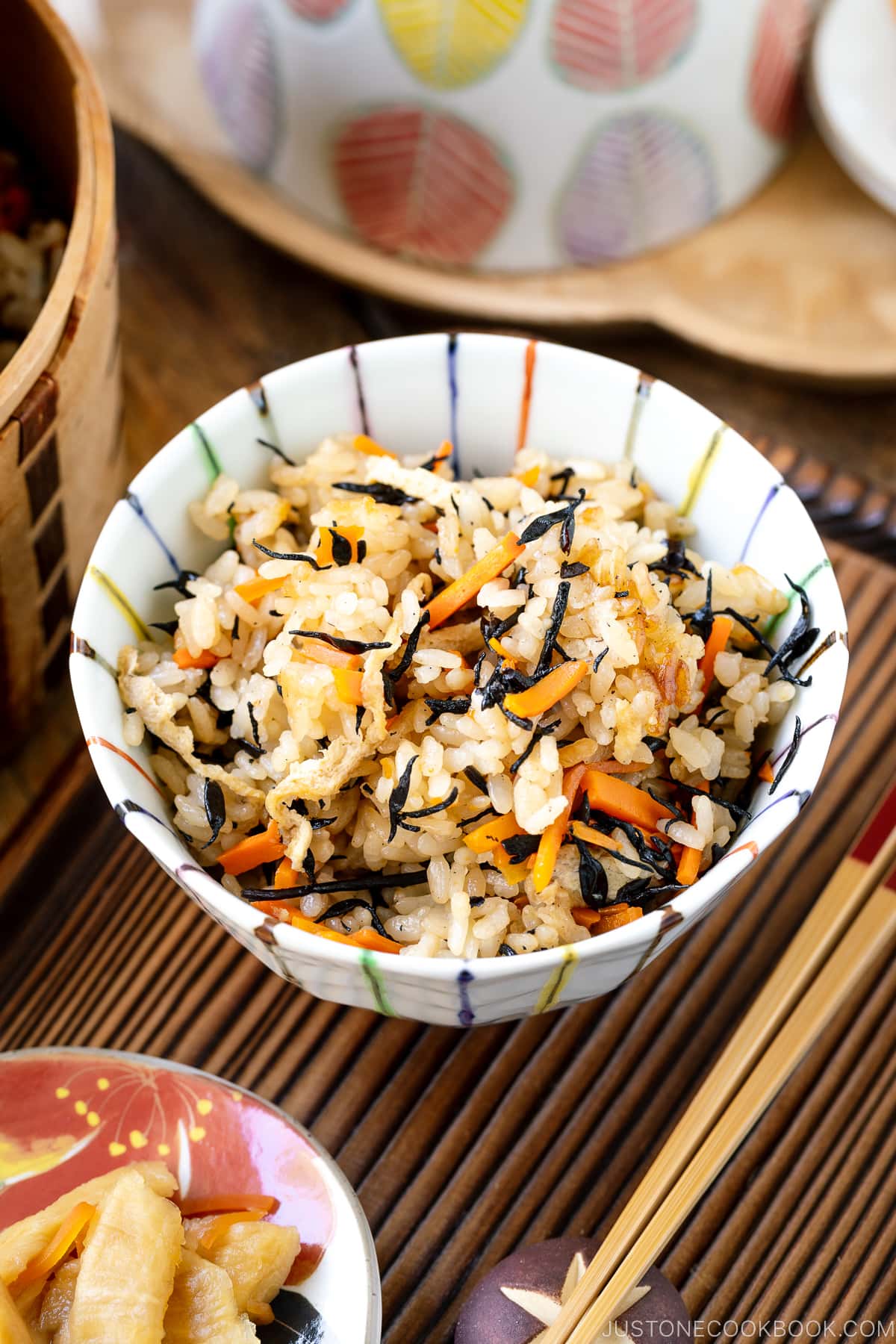
From a young age, I always loved classic Japanese ichiju sansai style meals with grilled fish, small sides, and rice and miso soup, while my friends were more interested in Western food and yoshoku (western-influenced Japanese food). I especially loved all kinds of Japanese mixed rice called takikomi gohan, and this Hijiki Rice was one of my favorites.
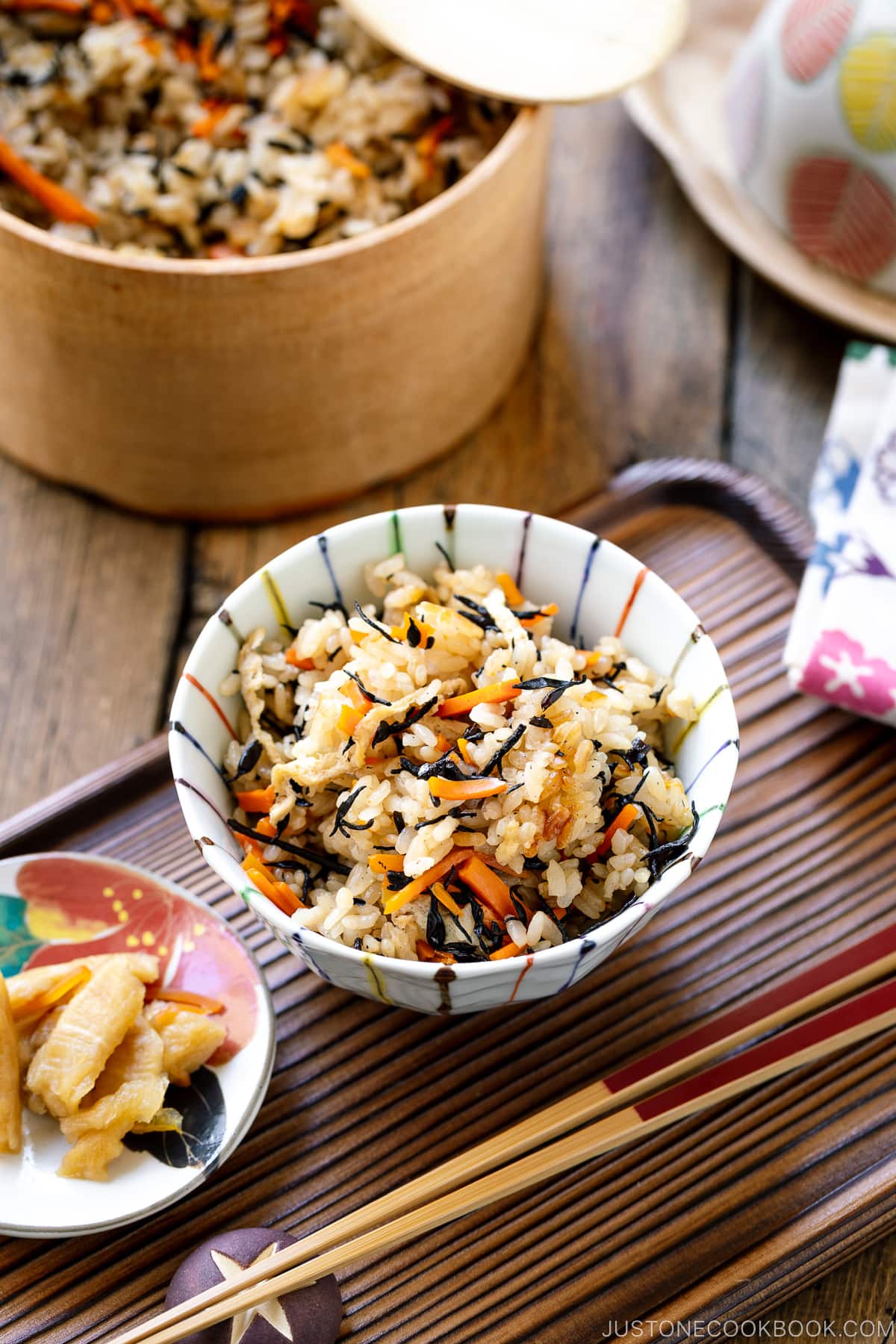
What is Takikomi Gohan?
Japanese Mixed Rice or what we call Takikoki Gohan (炊き込みご飯), is a Japanese dish made with short-grain rice and other ingredients. While regular rice is cooked with water, for mixed rice, we use dashi (Japanese soup stock) for more flavor.
Every season, we enjoy rice cooked with fresh seasonal ingredients, such as green peas or bamboo shoots in spring, corn in summer, sweet potato or chestnut in fall, and oyster or root vegetables in winter.
We would also serve mixed rice instead of plain white rice to complement a simple main dish for a colorful and appetizing meal.
What is Hijiki?
Hijiki (ひじき) is an edible dried seaweed renowned for its distinctive black, shredded appearance. Harvested along the rocky coastlines of Japan, Korea, and China, it starts as a vibrant green to brown hue when gathered, later transforming into a deep black after boiling and drying.
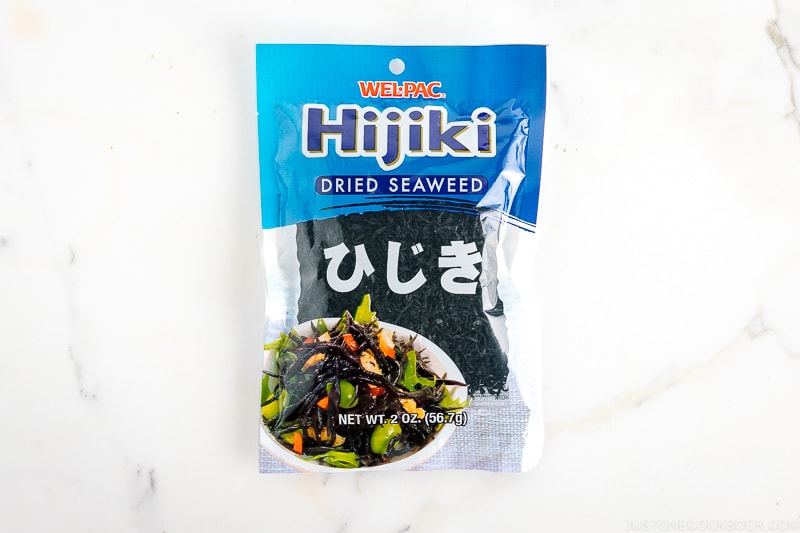
Unlike the other seaweeds like wakame and nori, hijiki has a savory and earthy flavor profile, with a subtle brininess that allows its unique taste to shine through. It offers a pleasant crunch and a chewy bite upon cooking.
This traditional food has been a part of a balanced diet in Japan for centuries, valued for its taste and nutritional richness. Packed with dietary fiber, vitamins, calcium, and essential minerals, hijiki is eaten in Japanese, Chinese, and Korean cuisine. Have you tried it before?
Where To Buy Hijiki
There are two types of hijiki seaweed: small, soft “bud” parts called mehijiki (芽ひじき), which I used in this recipe, and long, chewy “stem” parts called nagahijiki (長ひじき), which are not commonly found here in the U.S.
You can find hijiki in the dried foods aisle of Japanese, Asian, and Korean supermarkets, as well as in natural food stores. You can also buy it on Amazon.
If you’re concerned about the warning label on these products, just know that unless you consume an entire package in one day, there’s no need to worry. Typical consumption is unlikely to affect your health.
How to Use Hijiki in Cooking
Before using hijiki, soak it in cold water for 30 minutes. Drain well, rinse under running water, and it’s ready for use. You can make various hijiki recipes!
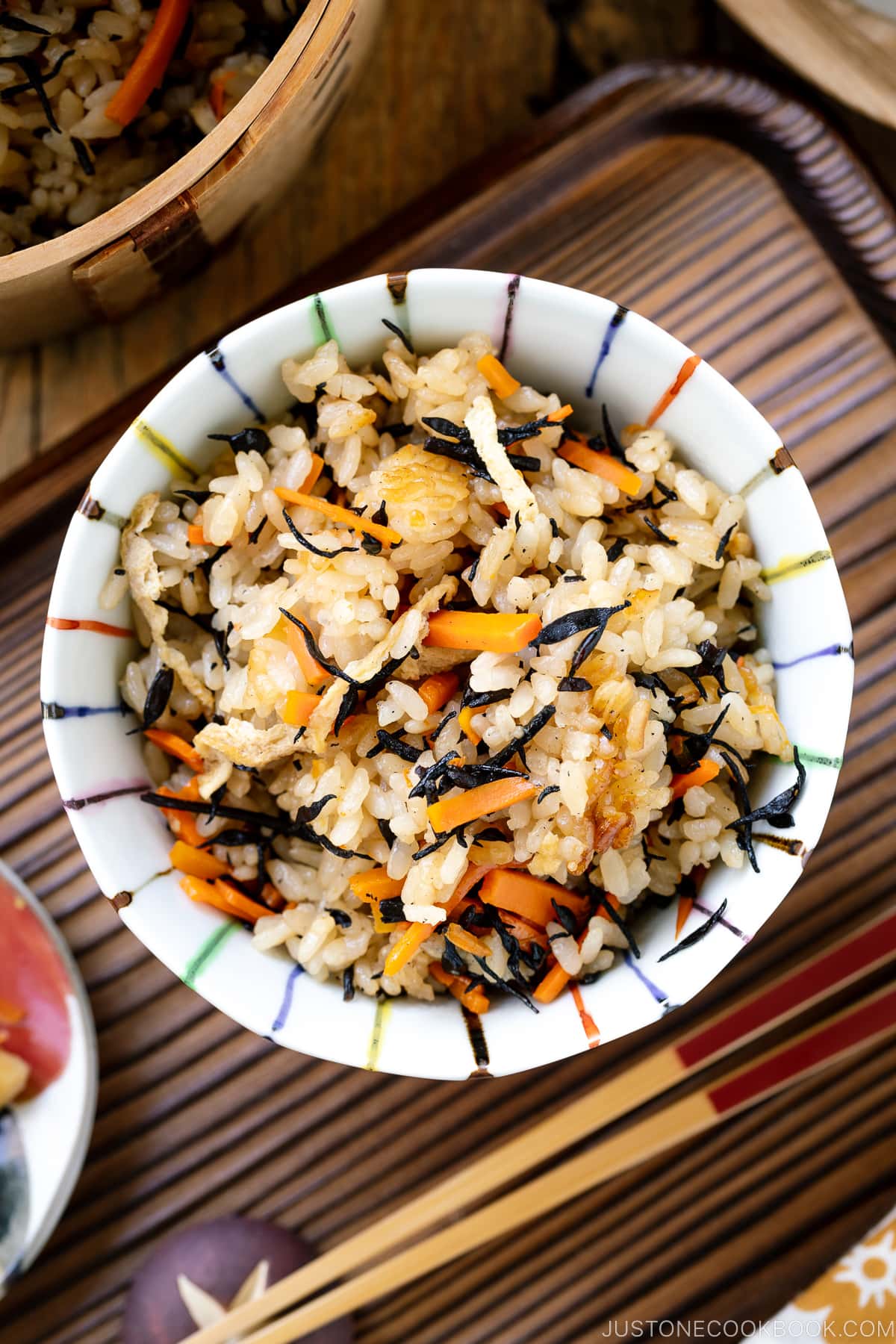
Ingredients for Hijiki Rice
- Japanese short-grain rice
- Hijiki seaweed
- Aburaage (fried tofu pouch)
- Carrot
- Seasonings: Vegan dashi, soy sauce (or tamari), mirin, and salt
This classic recipe is vegan-friendly with only plant-based ingredients. Typically, meat is not included, but you can do so by adding small pieces of chicken thighs.
How to Make the Best Hijiki Rice (Hijiki Gohan)
- Make vegan dashi by hydrating kombu and dried shiitake mushrooms.
- Soak hijiki seaweed and cut all the ingredients into small pieces.
- Rinse rice, and transfer to a rice cooker bowl (donabe, pot, or Instant Pot).
- Add the vegan dashi, seasonings, and ingredients, and start cooking.
- Let it steam after cooking, fluff the rice, and serve.
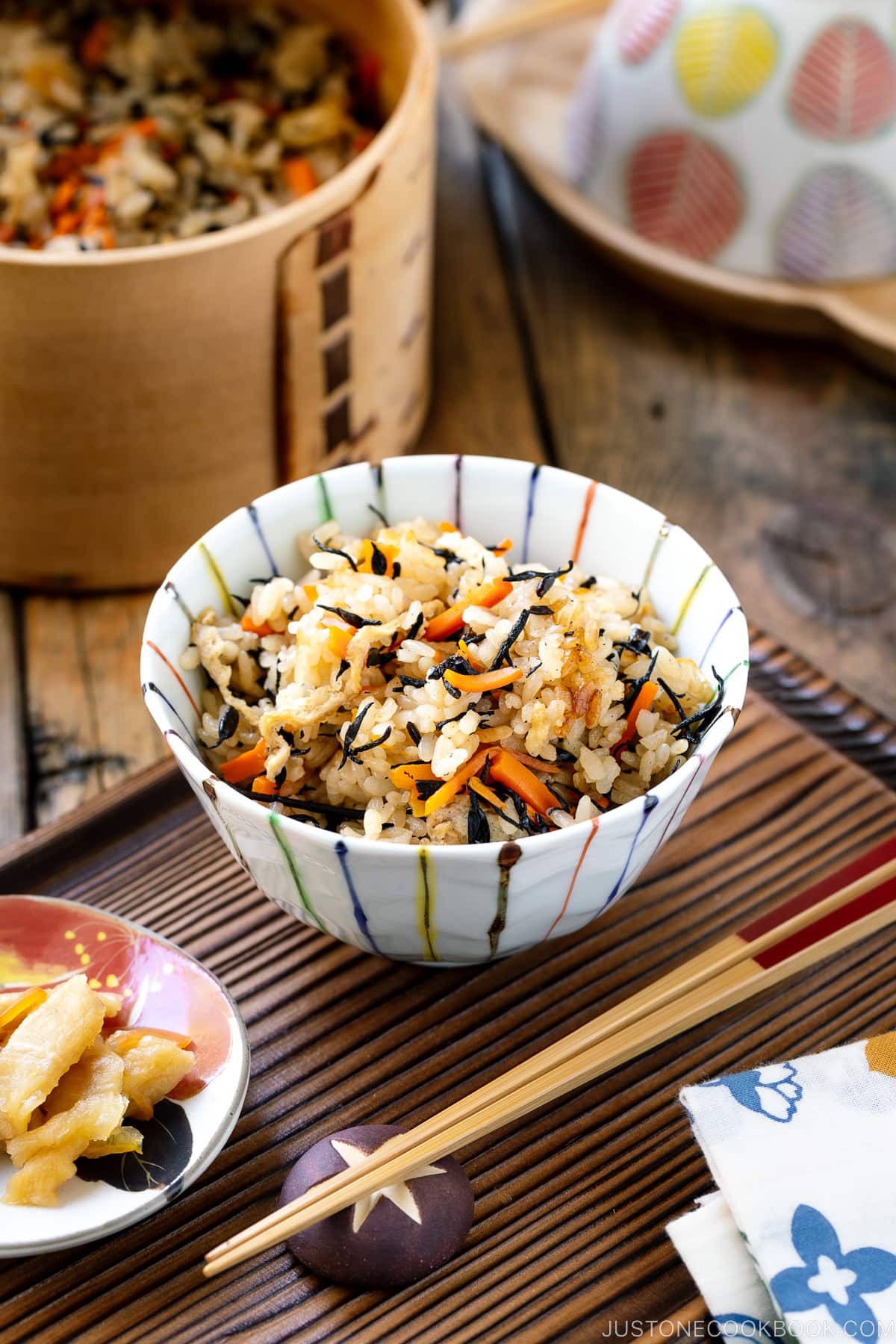
Cooking Tips
- Take note of the rice cooker cup – If you’ve never owned a rice cooker, you might not be familiar with the rice cooker cup measurement. 1 rice cooker cup is 180 ml, equivalent to 3/4 US cup. This measurement is standard for all brands of rice cookers. If your rice cooker comes with a clear rice cooker cup, it typically holds 180 ml.
- The ratio for Japanese short-grain rice to water is 1:1.1 or 1:1.2 – For 1 rice cooker cup (180 ml) of Japanese rice, you will need 200 ml of dashi, with seasonings factored into this calculation.
- Do not mix rice and ingredients – This applies to all mixed rice recipes. You first need to mix the rice, dashi, and seasonings, but add other ingredients such as veggies on top without blending them into the rice. This ensures the rice is cooked evenly. Once the rice is done cooking, you can then mix everything together.
- Always soak Japanese short-grain rice – The short-grain rice is more plump (thicker) than other varieties, so it requires a head start to absorb moisture to the core. Soaking for 20-30 minutes is standard.
- Repurpose leftover hijiki rice into onigiri (rice balls) – Shape the leftovers into rice balls and pack them in your bento lunch box. They were my favorite type of onigiri growing up!
How to Store
- To Refrigerate: I don’t recommend refrigerating cooked rice, even if you plan to eat it the next day, as the rice tends to become hard in cold temperatures.
- To Freeze: Store Hijiki Rice in an airtight container and freeze it for up to a month.
- To Reheat. For the best results, reheat in the microwave directly from frozen.
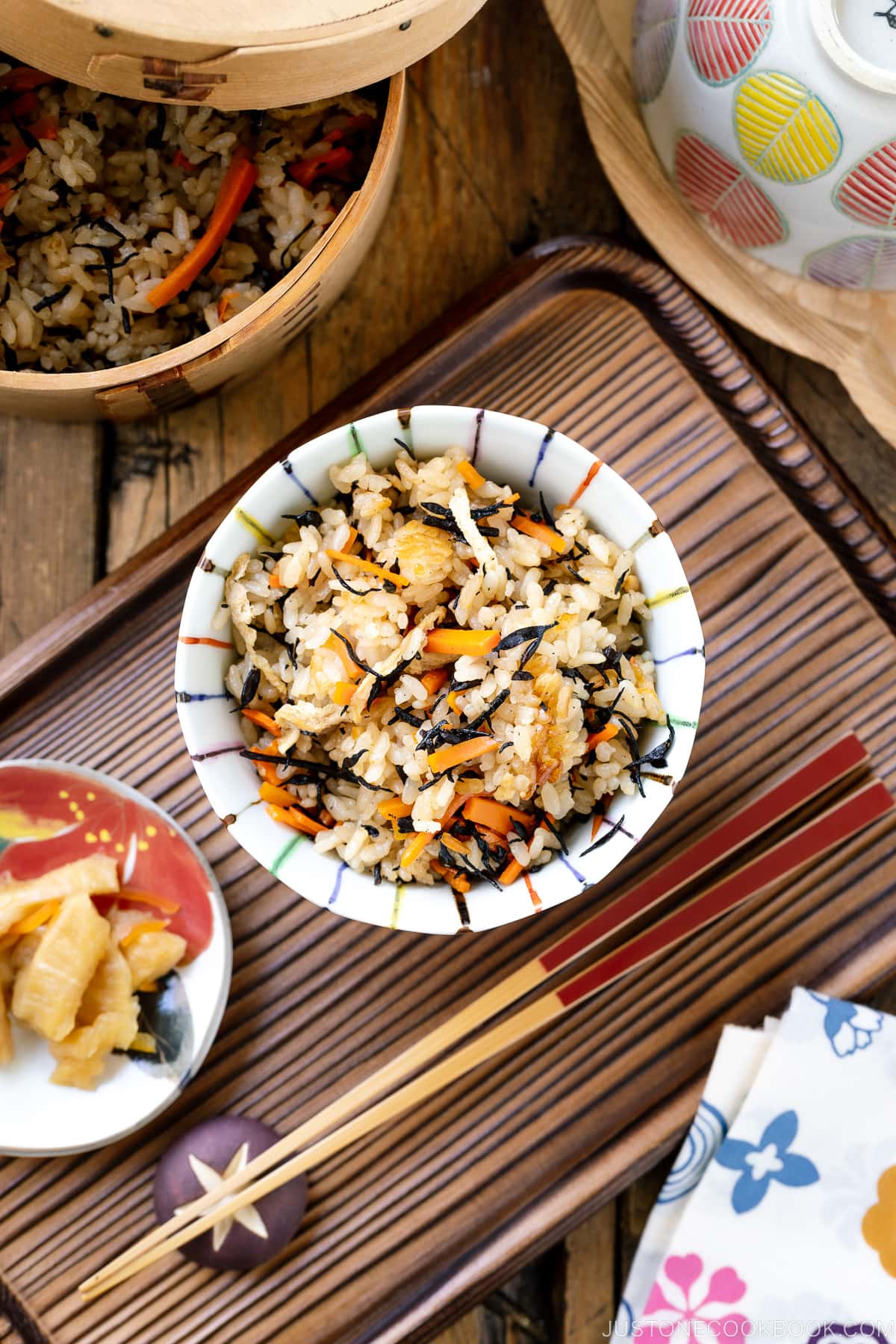
What to Serve with Hijiki Rice
To make a complete meal, here are my suggestions for the main dishes.
Other Delicious Mixed Rice Recipes
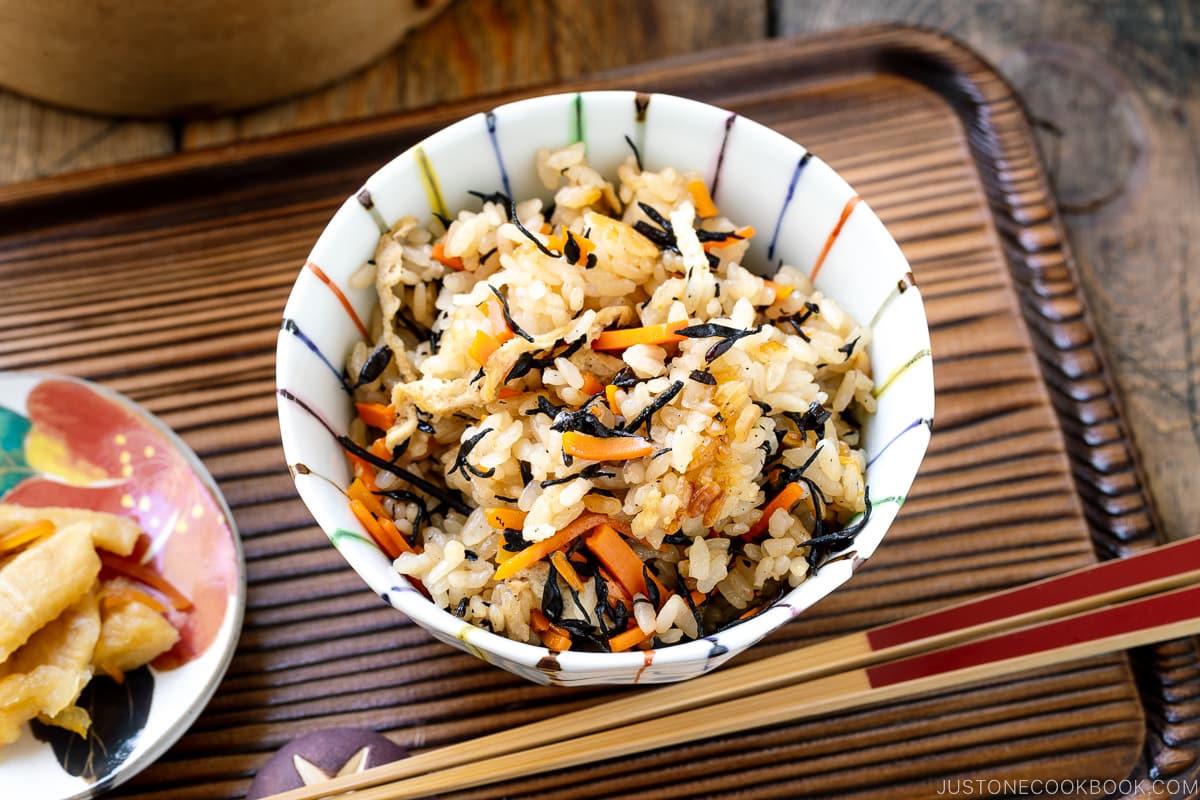
Wish to learn more about Japanese cooking? Sign up for our free newsletter to receive cooking tips & recipe updates! And stay in touch with me on Facebook, Pinterest, YouTube, and Instagram.
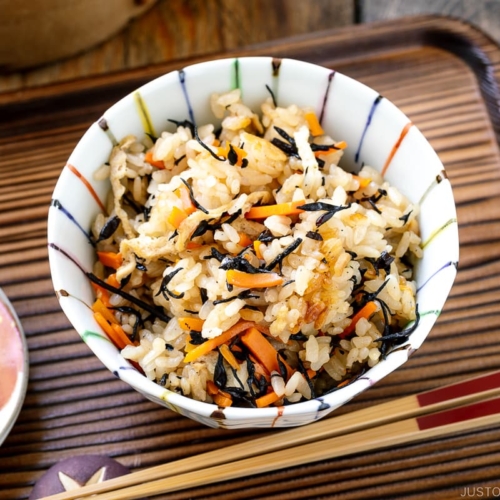
Hijiki Rice (Takikomi Gohan)
Hijiki Rice is a colorful Japanese mixed rice (takikomi gohan) cooked in seasoned dashi with seaweed, carrots, and aburaage fried tofu. An integral ingredient in the Japanese diet for centuries, hijiki is a savory sea vegetable rich in minerals and dietary fiber. Enjoy this classic recipe, which is also vegan-friendly.
Ingredients
For the Dashi (vegan-friendly)
Prevent your screen from going dark
Instructions
-
Gather all the ingredients. Please note that this dashi requires a minimum steeping time of 30 minutes. Ideally, we let the dashi steep for 2–3 hours in the summertime and 4–5 hours in the wintertime.
To Make the Dashi
-
Put 1 piece kombu (dried kelp), 2 pieces dried shiitake mushrooms, and 1⅓ cups water in a measuring cup. Let it steep on the counter for at least 30 minutes to extract the kombu’s flavor naturally. Tip: Most Japanese recipes recommend gently cleaning the kombu with a damp cloth. However, the kombu is pretty clean these days. Just make sure to dust off and remove mold spots, if any. Do not wash or wipe off the white powdery substance, as it has lots of umami. For the dried shiitake mushrooms, check if there is any dust or dirt trapped in the gills under the caps. If there is, use a pastry brush to clean it off. Do not wash it under water.
-
After steeping, it‘s now ready to use as cold brew Vegan Dashi.
-
Remove the hydrated kombu and shiitake from the measuring cup. See my suggestions at the end of the recipe for how to repurpose the spent kombu and shiitake. Then, add enough water to make 1⅓ cups (320 ml) dashi. Tip: The Japanese short-grain rice-to-water ratio is 1 to 1.1 (or 1.2). In this recipe, the dashi and seasonings together are considered the “water“ unit.
To Rehydrate the Hijiki Seaweed
-
Rehydrate 3 Tbsp dried hijiki seaweed in plenty of water to cover for 10 minutes. If you use nagahijiki, rehydrate for 20–30 minutes.
-
After 10 minutes, drain in a fine-mesh strainer and rinse under running water. Set aside.
To Wash the Rice
-
Put 1½ cups uncooked Japanese short-grain white rice in a large bowl and add just enough cold tap water to submerge the grains. Discard the water immediately (so the rice doesn‘t absorb the cloudy water). Next, use your fingers to gently wash the wet grains in a circular motion for 15–20 seconds. Add water to rinse and immediately pour off the cloudy water. Repeat this “wash and rinse“ process a couple more times until the water is clear. Drain the rice in a fine-mesh sieve and shake off the excess water. Set aside while you prepare the other ingredients.
To Cut the Ingredients
-
Cut 1 piece aburaage (deep-fried tofu pouch) in half lengthwise, then slice crosswise into thin strips (¼ inch, 6 mm).
-
Cut ⅓ carrot into thin slabs (⅛ inch, 3 mm) lengthwise. Then, cut the slabs into thin julienned strips; if they are too long, cut the strips in half.
To Cook the Rice
-
To your rice cooker pot (or donabe or heavy-bottomed pot), add the well-drained rice, 2 Tbsp usukuchi (light-colored) soy sauce, 2 Tbsp mirin, 1 Tbsp sake, and ½ tsp Diamond Crystal kosher salt.
-
Add the dashi. Then, mix the rice and seasonings well. Gently shake the pot and use your fingers to level the rice so that it‘s evenly distributed and submerged in the water.
-
Now, squeeze the hijiki seaweed one more time to drain the extra moisture. Then, sprinkle it on top of the rice in the pot. Do not mix with the rice! Next, scatter the carrot and aburaage on top. Again, do not mix with the rice. Tip: The rice will not cook evenly if mixed with the ingredients.
-
Use chopsticks to gently distribute ONLY the ingredients across the top of the rice so their flavors will release evenly. Close the lid. Let the rice soak for 20–30 minutes.For an electric rice cooker, choose the Mixed Rice menu, if available; otherwise, use the general setting. Then, start cooking.For a donabe or heavy-bottomed pot, cook on medium-high heat for about 13–15 minutes.After cooking, let the rice steam for 10–15 minutes. Do not open the lid during this time. This resting period is crucial for the rice to steam properly.
To Use the Spent Kombu and Shiitake
Nutrition
Nutrition Facts
Hijiki Rice (Takikomi Gohan)
Amount per Serving
% Daily Value*
* Percent Daily Values are based on a 2000 calorie diet.
Editor’s Note: This post was originally published on January 16, 2023. It was republished with more helpful information on April 3, 2024.





